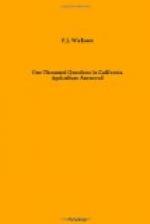Cloth for Hotbeds.
Would cloth do to cover a hotbox to raise lettuce, radishes, etc., for winter use where we get a very heavy rainfall?
Yes, if you make the cloth waterproof for its own preservation from mildew and other agencies of decay. The following recipe for waterproofing cloth is taken from our book on “California Vegetables”: Soften 4 1/2 ounces of glue in 8 3/4 pints of water, cold at first; then dissolve in, say, a washboiler full (6 gallons) of warm water, with 2 1/2 ounces of hard soap; put in the cloth and boil for an hour, wring and dry; then prepare a bath of a pound of alum and a pound of salt, soak the prepared cloth in it for a couple of hours, rinse with clear water and dry. One gallon of the glue solution will soak about ten yards of cloth. This cloth has been used in southern California for several years without mildewing, and it will hold water by the pailful. Where the rain is heavy and frequent, the cloth should be well supported by slats and given slope to shed water quickly. Of course, this is only a makeshift. Glass would be more satisfactory and durable in a region of much cloudiness and scant sunshine; the greater illumination through glass will make for the greater health and growth of the plants.
Soil for Vegetables.
Some of my soil bakes and hardens quickly after irrigation, but I have an acre or so of sandy soil. Would this be best for garden truck and berries?
Sandy, loamy soil is better than the heavy soil for vegetables and berries, if moisture is kept right, because it can be more easily cultivated and takes water without losing the friable condition which is so desirable. A heavier soil can, however, be improved by the free use of stable manure or by the addition of sand, or by the use of one or more applications of lime at the rate of 500 pounds to the acre, as may be required — all these operations making the soil more loamy and more easily handled.
Vegetables in a Cold, Dark Draft.
What vegetables will thrive in localities where the sun shines only part of the day? I have a space in my garden that gets the sun only between the hours of 11 and 5, thereabouts; I would like to utilise those places for vegetables if any particular kind will grow under such conditions. The soil apparently is good, of a sandy nature, with some loam. The place is high and subject to much wind.
You can only definitely determine by actual trial what vegetables will be satisfactory under the shade conditions which you describe. You may get good results from lettuces, radishes, beets, peas, top onions, and many other things which do well at rather a low temperature, while tomatoes, peppers, eggplant, etc., would probably be worthless. Your soil is probably satisfactory and you can easily keep the moisture right by being careful not to use as much water as you would in open sunshine. The behavior of the plants will be directly dependent upon the temperature and the sunshine which they receive under the conditions described.




